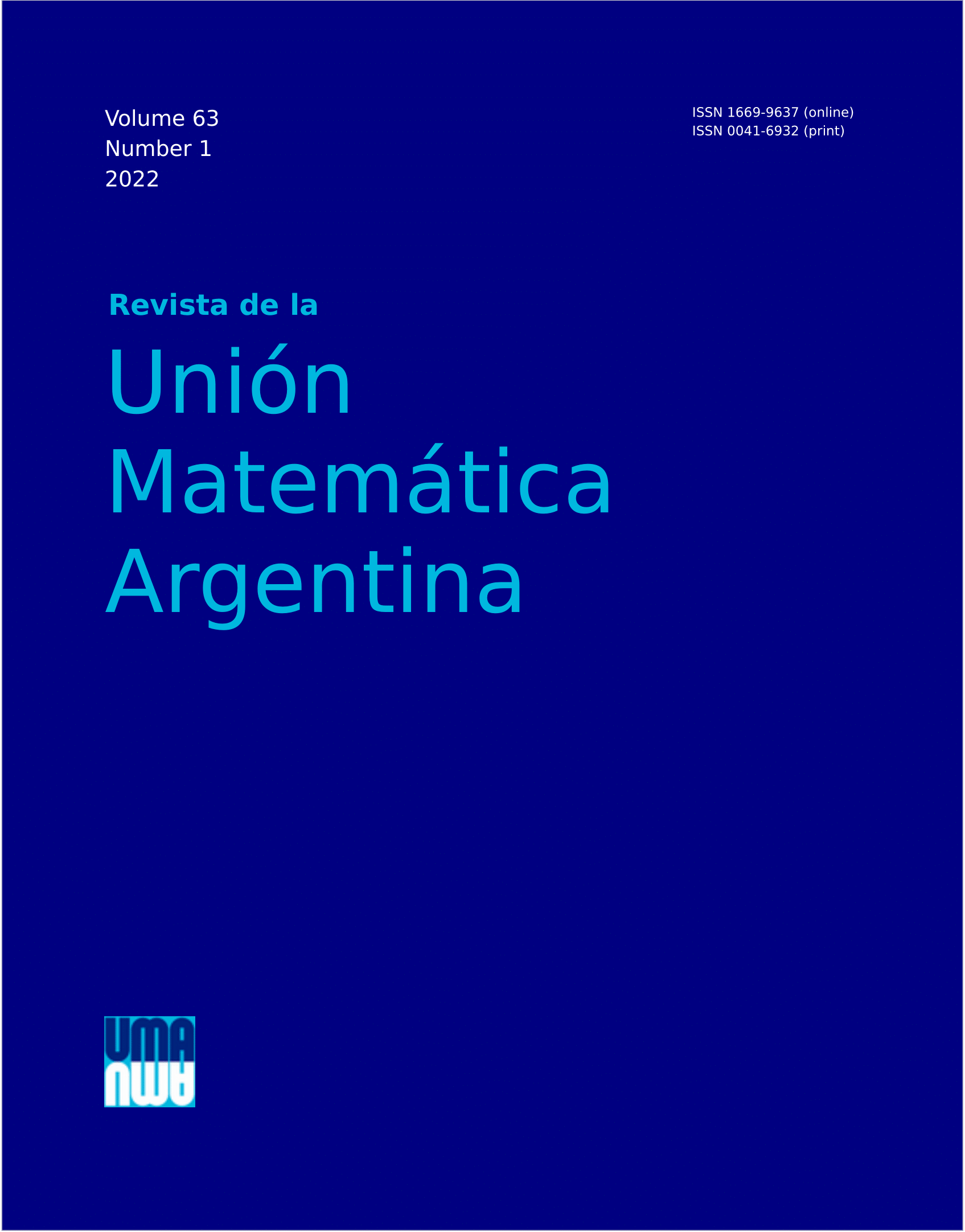Stability conditions and maximal green sequences in abelian categories
DOI:
https://doi.org/10.33044/revuma.1110Abstract
We study the stability functions on abelian categories introduced by Rudakov and their relation with torsion classes and maximal green sequences. Moreover, we introduce the concept of red paths, a stability condition in the sense of Rudakov that captures information of the wall and chamber structure of the category.
Downloads
References
T. Adachi, O. Iyama and I. Reiten, $tau$-tilting theory, Compos. Math. 150 (2014), no. 3, 415–452. MR 3187626.
L. Angeleri Hügel, Infinite dimensional tilting theory, in Advances in Representation Theory of Algebras, 1–37, EMS Ser. Congr. Rep., European Mathematical Society, Zürich, 2013. MR 3220532.
I. Assem, D. Simson and A. Skowroński, Elements of the Representation Theory of Associative Algebras. Vol. 1, London Mathematical Society Student Texts, 65, Cambridge University Press, 2006. MR 2197389.
M. Auslander, I. Reiten and S. O. Smalø, Representation Theory of Artin Algebras, corrected reprint of the 1995 original, Cambridge Studies in Advanced Mathematics, 36, Cambridge University Press, 1997. MR 1476671.
E. Barnard, A. Carroll and S. Zhu, Minimal inclusions of torsion classes, Algebr. Comb. 2 (2019), no. 5, 879–901. MR 4023570.
P. Baumann, J. Kamnitzer and P. Tingley, Affine Mirković–Vilonen polytopes, Publ. Math. Inst. Hautes Études Sci. 120 (2014), 113–205. MR 3270589.
T. Bridgeland, Stability conditions on triangulated categories, Ann. of Math. (2) 166 (2007), no. 2, 317–345. MR 2373143.
T. Bridgeland, Scattering diagrams, Hall algebras and stability conditions, Algebr. Geom. 4 (2017), no. 5, 523–561. MR 3710055.
T. Brüstle, G. Dupont and M. Pérotin, On maximal green sequences, Int. Math. Res. Not. IMRN 2014, no. 16, 4547–4586. MR 3250044.
T. Brüstle, D. Smith and H. Treffinger, Stability conditions, $tau$-tilting theory and maximal green sequences, https://arxiv.org/abs/1705.08227 [math.RT], 2017.
T. Brüstle, D. Smith and H. Treffinger, Wall and chamber structure for finite-dimensional algebras, Adv. Math. 354 (2019), 106746, 31 pp. MR 3989130.
L. Demonet, O. Iyama and G. Jasso, $tau$-tilting finite algebras, bricks, and $g$-vectors, Int. Math. Res. Not. IMRN 2019, no. 3, 852–892. MR 3910476.
S. E. Dickson, A torsion theory for Abelian categories, Trans. Amer. Math. Soc. 121 (1966), 223–235. MR 0191935.
M. Engenhorst, Tilting and refined Donaldson–Thomas invariants, J. Algebra 400 (2014), 299–314. MR 3147376.
M. Gross, P. Hacking, S. Keel and M. Kontsevich, Canonical bases for cluster algebras, J. Amer. Math. Soc. 31 (2018), no. 2, 497–608. MR 3758151.
B. Keller, On cluster theory and quantum dilogarithm identities, in Representations of Algebras and Related Topics, 85–116, EMS Ser. Congr. Rep., European Mathematical Society, Zürich, 2011. MR 2931896.
A. D. King, Moduli of representations of finite-dimensional algebras, Quart. J. Math. Oxford Ser. (2) 45 (1994), no. 180, 515–530. MR 1315461.
D. Mumford, Geometric Invariant Theory, Ergebnisse der Mathematik und ihrer Grenzgebiete (N.F.), Band 34, Springer-Verlag, 1965. MR 0214602.
A. Rudakov, Stability for an abelian category, J. Algebra 197 (1997), no. 1, 231–245. MR 1480783.
R. Schiffler, Quiver Representations, CMS Books in Mathematics/Ouvrages de Mathématiques de la SMC, Springer, 2014. MR 3308668.
A. Schofield, Semi-invariants of quivers, J. London Math. Soc. (2) 43 (1991), no. 3, 385–395. MR 1113382.
Downloads
Published
Issue
Section
License
Copyright (c) 2022 Thomas Brüstle, David Smith, Hipolito Treffinger

This work is licensed under a Creative Commons Attribution 4.0 International License.
Authors who publish with this journal agree to the following terms:
Authors retain copyright and grant the journal right of first publication with the work simultaneously licensed under a Creative Commons Attribution License that allows others to share the work with an acknowledgment of the work's authorship and initial publication in this journal. The Journal may retract the paper after publication if clear evidence is found that the findings are unreliable as a result of misconduct or honest error.

